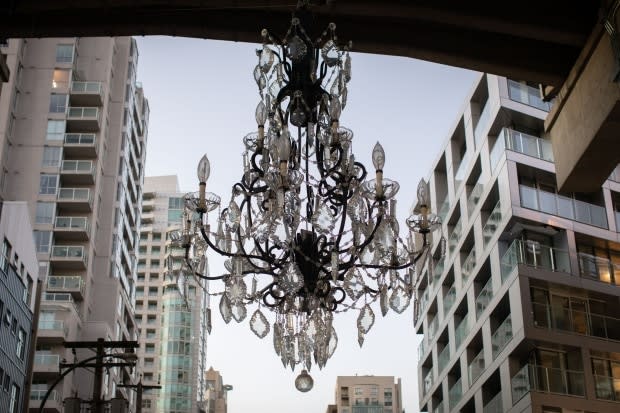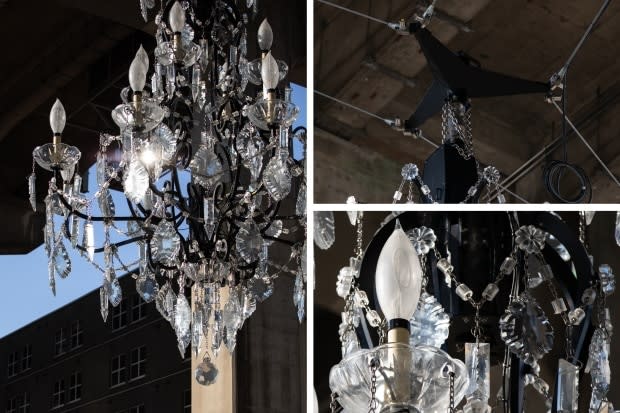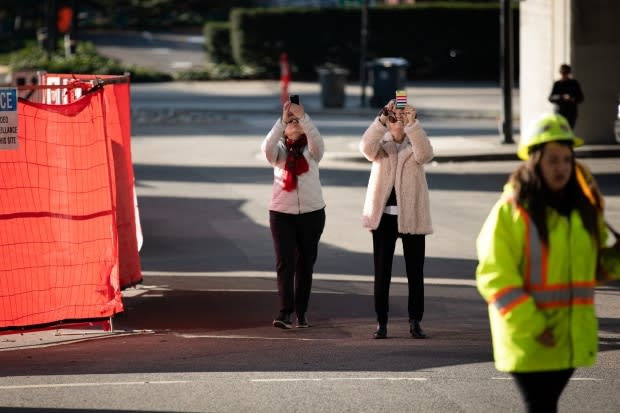A $4.8M chandelier under Vancouver's Granville Bridge draws divided response
As Pierre Blais crossed the noisy construction site Wednesday on Vancouver's Beach Avenue, dodging the forklifts and street sweepers, he nearly didn't see the massive chandelier dangling above him.
It wasn't until he paused and a construction worker pointed above, twirling her finger in a circular motion, that he stumbled upon the city's newest public art installation.
"It's gaudy," said Blais, a 51-year-old small business owner, gazing at the chandelier's 600 faux crystals. "If that was the demographic they're aiming for, they nailed it."
Blais, who has lived for five years in the neighbourhood, reflects the polarizing response to the installation since its grand unveiling this week.
In a city grappling with a housing and homelessness crisis, the chandelier has ignited criticisms of Versailles-like grandeur and excess, fuelled by its eye-popping $4.8-million price tag.
The piece, titled Spinning Chandelier, was designed by B.C. artist Rodney Graham, who based it on a 2005 film installation of a whirling chandelier.
The fixture spans 7.7 metres in height and 4.2 metres in length and is made of stainless steel, LED lamps and polyurethane faux crystals.
Every so often, the chandelier descends from the north end of the Granville Bridge, spins for about four minutes while flashing its lights, then retreats into the bridge's underbelly.
"The price tag is way too high for what it is," said Janice Rafael, a 58-year-old retired artist, who walks by the area daily.
Rafael said she wishes part of that money had gone to adding artwork or amenities at May and Lorne Brown Park, a small, busy green space a block away.
The installation was commissioned and paid for by the luxury property developer Westbank as part of its Vancouver House project. The site's centrepiece is a twisting, Jenga-like highrise, just north of the chandelier.
In a written statement, Westbank said there will always be critics when it comes to spending on public art.
"There is a pervasive attitude in our city that we must choose between contributing to social infrastructure or making other contributions, whether artistic or cultural, that are seen as less functional," the developer wrote.
"Westbank does not view this as an 'either or' situation."

Changing neighbourhood
Westbank was required to provide a public art piece for Vancouver House under the city's bylaws.
It first pegged the cost at $1.2 million in its 2015 proposal to city council, but that number ballooned to $4.8 million as the project's complexity came to light.
The city allowed Westbank to pool funds from three other developments to create one larger installation. Westbank covered the entire cost of the chandelier and is on the hook for any maintenance.
As part of the city's rezoning conditions, Westbank will contribute 106 new rental homes and more than $21 million in levies to the city.
Units in the Vancouver House, however, cater to the wealthy: A three-bedroom unit is listed at $6.9 million, while a two-bedroom penthouse is up for nearly $9 million.
The development has drawn a flurry of activity to a historically industrial area, where the homeless have often sought refuge under the bridge.

Eric Fredericksen, head of public art for the City of Vancouver, said the chandelier will bring more people to the "rough and functional" space. But he's mindful of the criticism.
"For the artist, I think he was thinking more abstractly about the sculpture and the light possibilities in the chandelier. I'm not sure how much the social implications are in there," Fredericksen said.
"But they are there now and I think they'll be part of the reading of the piece, which is a spectacular object. I'm curious as to how that conversation will play out over time."
For some, the chandelier is best viewed as a feat of design. Desmond Williams, a 59-year-old engineer, scrutinized the chandelier as crews tested out the chandelier.
"I don't know if it's the best public art that I would see for this area. I haven't decided," Williams said.
Just then, the chandelier began to spin, its crystals flaring out like wings. Williams' face lit up.
"Already I'm liking it," he said. "I think with light, it could be really cool."



